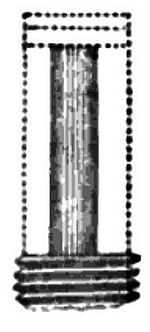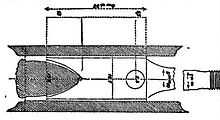Carabine à tige


The Carabine à tige was invented by Louis-Etienne de Thouvenin. The method was an improvement of the invention of fellow Frenchman Henri-Gustave Delvigne. Delvigne had developed chambered carbines and rampart rifle-muskets so that when forced against the chamber rim by ramming (with three strokes of a heavy ram), the bullet would become deformed and flatten, so as to expand in diameter against the inside of the bore, allowing the bullet to press against the rifling grooves. When fired, the bullet would accompany the rifling and spin.[1]
Carabine à tige
Thouvenin induced the deformation of the bullet by placing a steel stem inside and at the center of the powder chamber, around which powder was inserted, and on top of which the bullet was dropped. When hit by the ram, the bullet would expand radially against the rifling grooves and at the same time wrap around the stem, giving it a more efficient and aerodynamic shape.[2][3] Colonel Thouvenin published his invention in 1844.[4]
This system, although an improvement over Delvigne's method, would still not allow for a perfect engagement in the rifle, rendering the ball's trajectory rather erratic.[4] The French Army however adopted the improvement in 1846.[4] The Chasseurs adopted the system in 1853,.,[2] as well as the Prussian Jägers,[5] corps where marksmen skills were essential.
The rifles would be known as Thouvenin tige rifles ("Carabines à tige Thouvenin"). The weapons used a 600 yards sight and used a hair trigger. The barrels were rifled with 8 grooves, making a turn every 36 inches.[5]
The Thouvenin rifles had the inconvenience that they were very difficult to clean, especially the area around the stem.
Legacy
This development would be a precursor to the invention of the Minié ball by Claude-Étienne Minié, as Thouvenin had already suggested that bullet with a hollowed base would be most efficient.[2] Minié further developed his iron culot, with the objective of forcing the bullet outwards towards the groove through the impact of the culot against the inertia of the lead ball, in the same way as the Thouvenin stem, before even making without the culot.[2] The much simpler system would supersede the Thouvenin tige gun, even allowing the transformation of any smoothbore into a powerful rifled gun ("Fusil rayé"), simply by the making of rifling grooves and usage of the appropriate Minié bullet, available to all the troops of the line.[6]
| Preceded by Delvigne rifle |
French Army rifle 1846–1851 |
Succeeded by Minié rifle |
Notes
- ↑ The Artillerist's Manual by John Gibbon p.125
- ↑ 2.0 2.1 2.2 2.3 The Artillerist's Manual 1860, by John Gibbon, p.135
- ↑ Military Commission to Europe in 1855 and 1856 by United States Military p.221
- ↑ 4.0 4.1 4.2 Rifles by David Westwood p.23
- ↑ 5.0 5.1 Rifles By David Westwood, p.81
- ↑ The Artillerist's Manual By John Gibbon p.136
| ||||||||||||||||||||||||||||||||
